steering CHEVROLET CAMARO 1967 1.G Chassis Manual Online
[x] Cancel search | Manufacturer: CHEVROLET, Model Year: 1967, Model line: CAMARO, Model: CHEVROLET CAMARO 1967 1.GPages: 659, PDF Size: 114.24 MB
Page 476 of 659
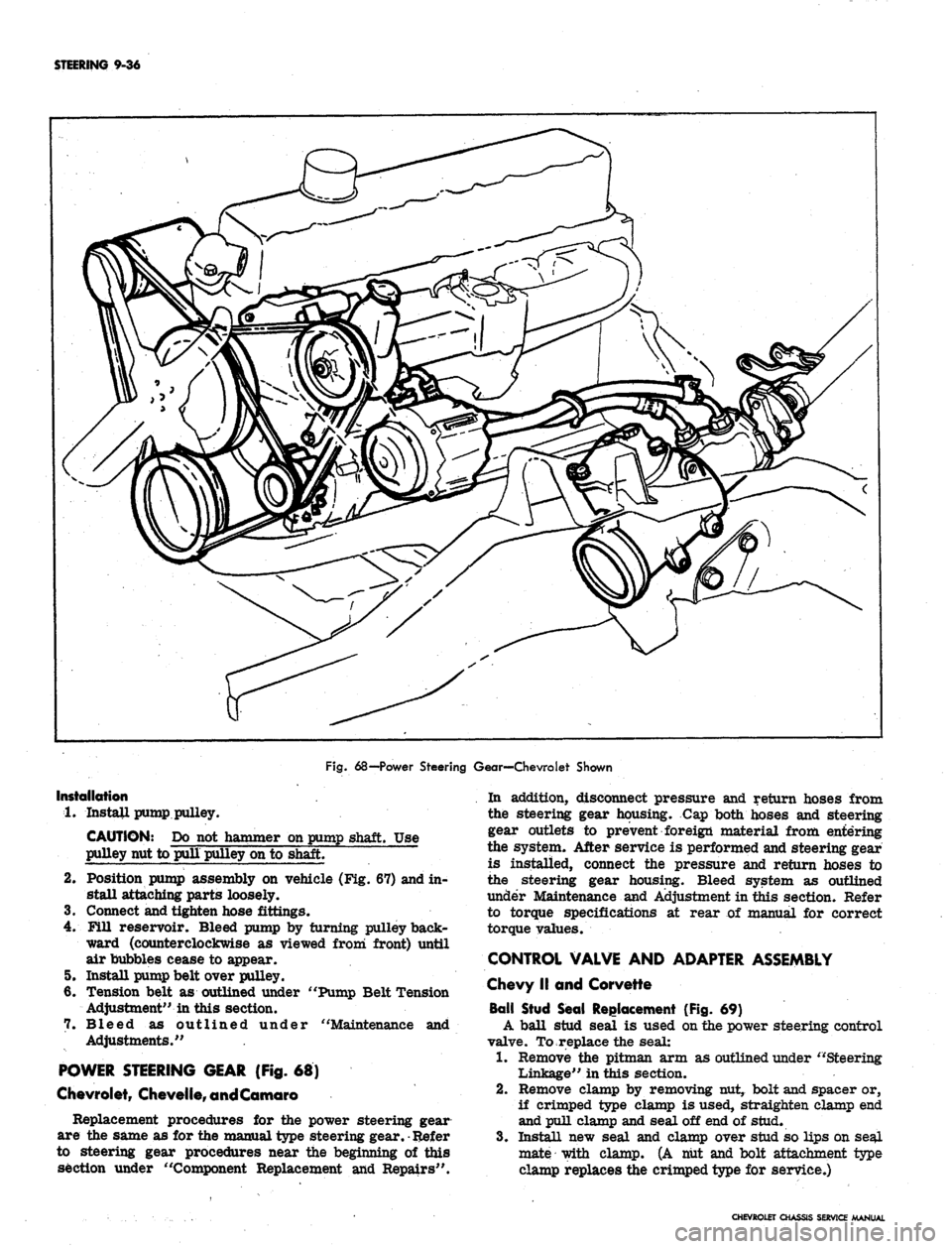
STEERING 9-36
Fig.
68—Power Steering Gear—Chevrolet Shown
Installation
1.
Install pump pulley.
CAUTION: Do not hammer on pump shaft. Use
pulley nut to pull pulley on to shaft.
2.
Position pump assembly on vehicle (Fig. 67) and in-
stall attaching parts loosely.
3.
Connect and tighten hose fittings.
4.
Fill reservoir. Bleed pump by turning pulley back-
ward (counterclockwise as viewed from front) until
air bubbles cease to appear.
5. Install pump belt over pulley.
6. Tension belt as outlined under "Pump Belt Tension
Adjustment" in this section.
7. Bleed as outlined under "Maintenance and
Adjustments."
POWER STEERING GEAR (Fig. 68)
Chevrolet,
Chevelfe,
and Comoro
Replacement procedures for the power steering gear
are the same as for the manual type steering gear.
•
Refer
to steering gear procedures near the beginning of this
section under "Component Replacement and Repairs".
In addition, disconnect pressure and return hoses from
the steering gear housing. Cap both hoses and steering
gear outlets to prevent foreign material from entering
the system. After service is performed and steering gear
is installed, connect the pressure and return hoses to
the steering gear housing. Bleed system as outlined
under Maintenance and Adjustment in this section. Refer
to torque specifications at rear of manual for correct
torque values.
CONTROL VALVE AND ADAPTER ASSEMBLY
Chevy II and Corvette
Ball Stud Seal Replacement (Fig. 69)
A ball stud seal is used on the power steering control
valve. To replace the seal:
1.
Remove the pitman arm as outlined under "Steering
Linkage" in this section.
2.
Remove clamp by removing nut, bolt and spacer or,
if crimped type clamp is used, straighten clamp end
and pull clamp and seal off end of stud.
3.
Install new seal and clamp over stud so lips on seal
mate with clamp. (A nut and bolt attachment type
clamp replaces the crimped type for service.)
CHEVROLET CHASSIS
SERVICE
MANUAL
Page 477 of 659
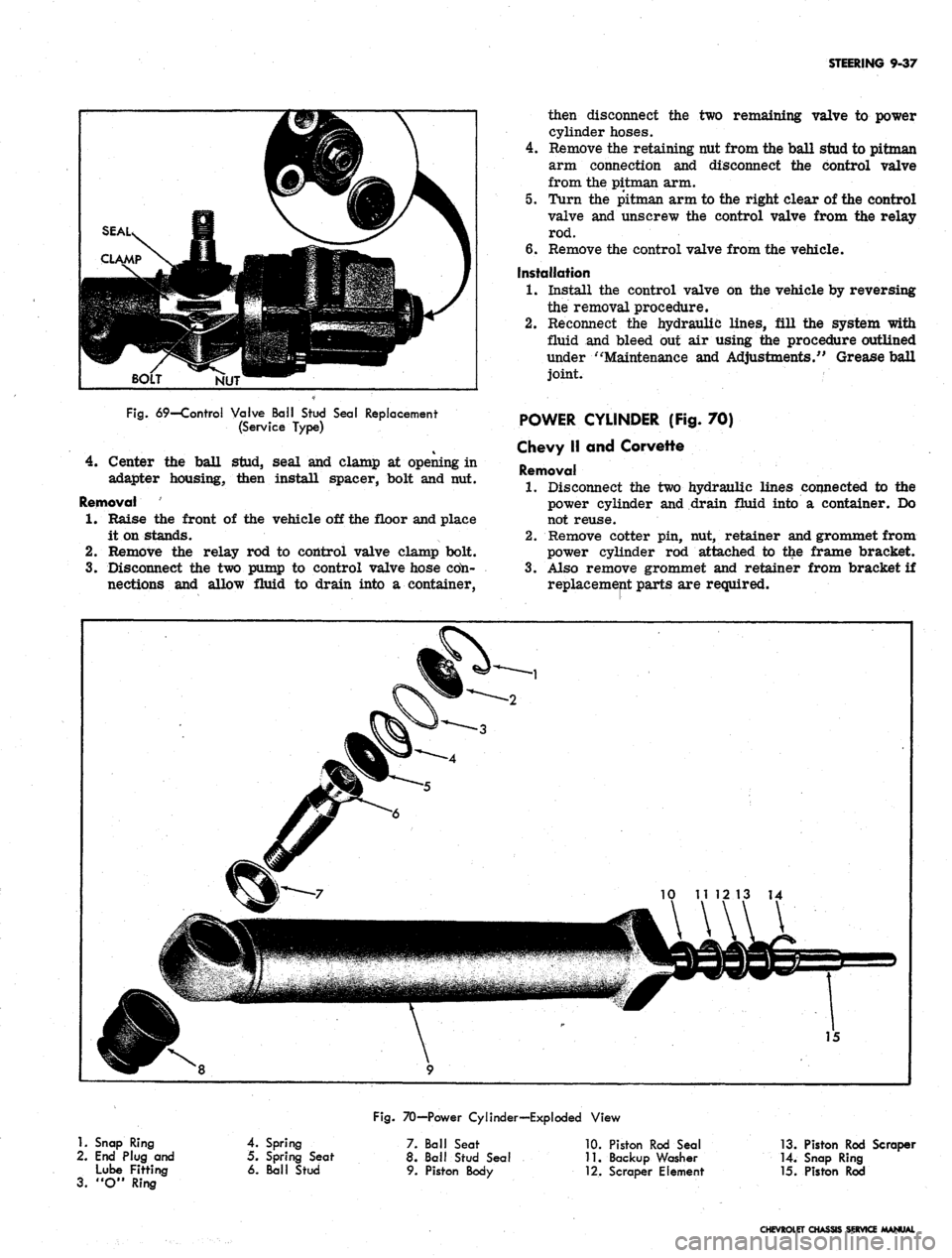
STEERING 9-37
NUT
Fig.
69—Control Valve Ball Stud Seal Replacement
(Service Type)
4.
Center the ball stud, seal and clamp at opening in
adapter housing, then install spacer, bolt and nut.
Removal
1.
Raise the front of the vehicle off the floor and place
it on stands.
2.
Remove the relay rod to control valve clamp bolt.
3.
Disconnect the two pump to control valve hose cdn-
nections and allow fluid to drain into a container,
then disconnect the two remaining valve to power
cylinder hoses.
4.
Remove the retaining nut from the ball stud to pitman
arm connection and disconnect the control valve
from the pitman arm.
5. Turn the pitman arm to the right clear of the control
valve and unscrew the control valve from the relay
rod.
6. Remove the control valve from the vehicle.
Installation
1.
Install the control valve on the vehicle by reversing
the removal procedure.
2.
Reconnect the hydraulic lines, fill the system with
fluid and bleed out air using the procedure outlined
under "Maintenance and Adjustments/' Grease ball
joint.
POWER CYLINDER (Fig. 70)
Chevy II and Corvette
Removal
1.
Disconnect the two hydraulic lines connected to the
power cylinder and drain fluid into a container. Do
not reuse.
2.
Remove cotter pin, nut, retainer and grommet from
power cylinder rod attached to the frame bracket.
3.
Also remove grommet and retainer from bracket if
replacement parts are required.
1.
Snap Ring
2.
End Plug and
Lube Fitting
3.
"O" Ring
Fig.
70—Power Cylinder—Exploded View
4.
Spring
5. Spring Seat
6. Ball Stud
7. Ball Seat
8. Ball Stud Seal
9. Piston Body
10.
Piston Rod Seal
11.
Backup Washer
•12.
Scraper Element
13.
Piston Rod Scraper
14.
Snap Ring
15.
Piston Rod
CHEVROLET CHASSIS SERVICE MANUAL
Page 478 of 659
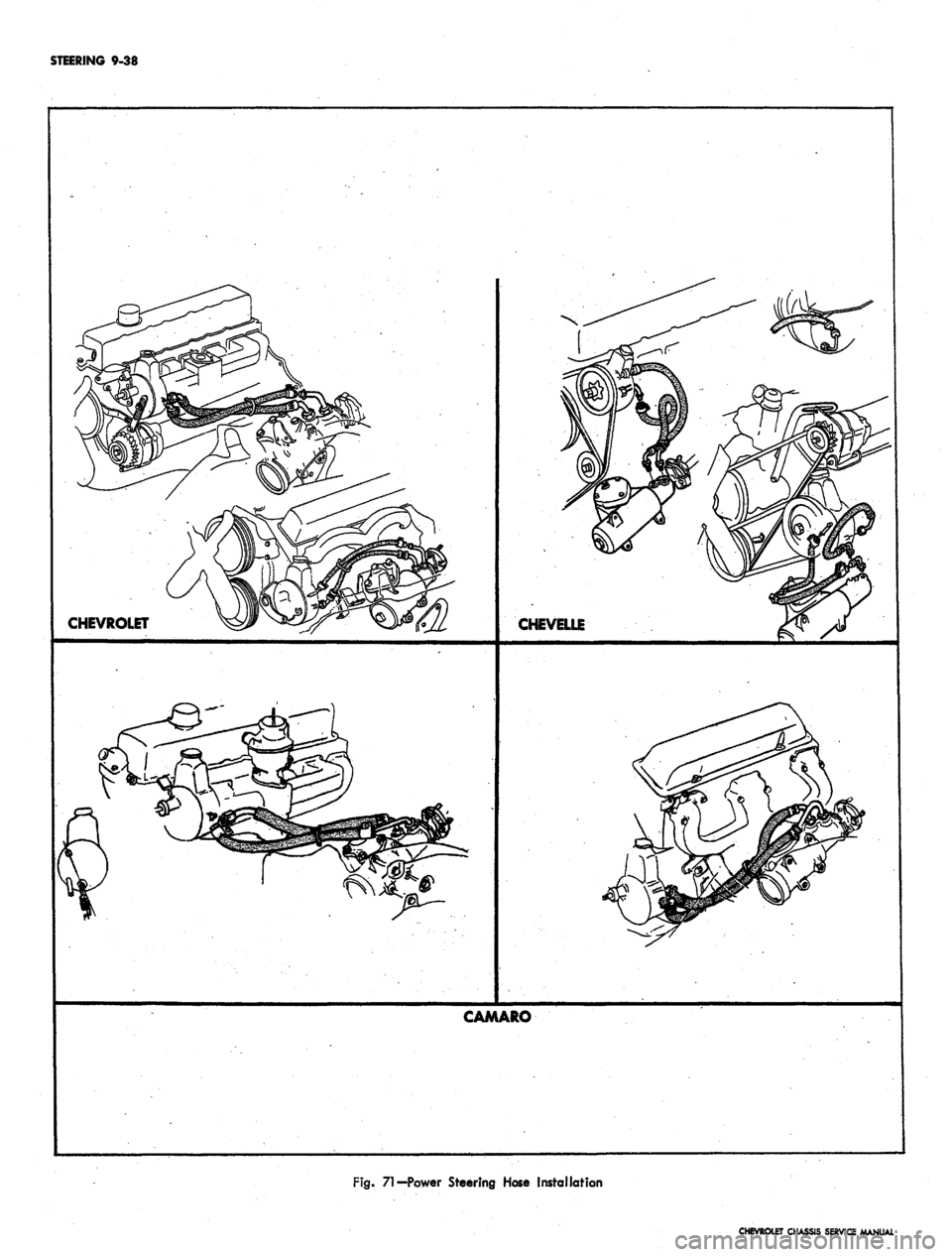
STEERING 9-38
CHEVROLET
CHEVELLE
CAMARO
Fig.
71—Power Steering Hose Installation
CHEVROLET CHASSIS SERVICE MANUAL
Page 479 of 659

STEERING 9-39
4.
Remove cotter pin, nut and ball stud at relay rod.
5. Remove the power cylinder from the vehicle.
Inspection
1.
Inspect the seals for leaks; if leaks are present,
replace the seals using the procedure outlined under
"Disassembly."
2.
Examine the brass fitted hose connection seats for
cracks or damage and replace if necessary.
3.
For service other than ball seat or seal replacement
and ball stud removal, replace the power cylinder.
4.
Check the frame bracket parts for wear.
Disassembly
1.
To remove the piston rod seal remove the snap ring;
then pull out on the rod, being careful not to spray
oil.
2.
Remove the piston rod scraper and scraper element,
back up washer and piston rod seal from the rod.
3.
At the ball stud end of the cylinder, remove the ball
stud seal.
4.
Remove the snap ring retaining the end plug with the
lube fitting.
5. Push on the end of the ball stud and remove the end
plug, spring, spring seat and ball stud.
6. Remove the "O" ring seal from the top lip of the
power cylinder ball stud opening.
7. If the ball seat is to be replaced, it must be pressed
out using Tool J-8937.
Assembly
1.
Reassemble the piston rod seal components by re-
versing the disassembly procedure. Apply a thin
coat of Lubriplate or equivalent on the inner sur-
faces of the seal and scraper before assembly.
2.
Reverse the disassembly procedure when reassem-
bling the ball stud.
3.
In each case be sure that the snap ring is securely,
seated in the ring groove.
Installation
1.
Install the power cylinder on the vehicle by reversing
the removal procedure.
2.
Reconnect the two hydraulic lines, fill the system
with fluid and bleed out air using the procedure out-
lined under "Maintenance and Adjustments." Grease
ball joint.
POWER STEERING HOSES
When servicing the power steering hoses be sure to
align the hoses in their correct position as shown in
Figure 71. On Chevelle models with 396 engine, install
the upper hose so that there is at least .6 inch clearance
between the hose and the Delcotron or the inner fender
skirt.
It is important that the power steering hoses be in-
stalled correctly. Hoses installed out of position may be
subjected to chafing or other abuses during sharp turns.
Always make hose installations with front wheels in
straight ahead position. Do not twist hoses unneces-
sarily during installation.
CAUTION: Do not start engine with any power
steering hose disconnected.
CHEVROLET CHASSIS SERVICE MANUAL
Page 480 of 659
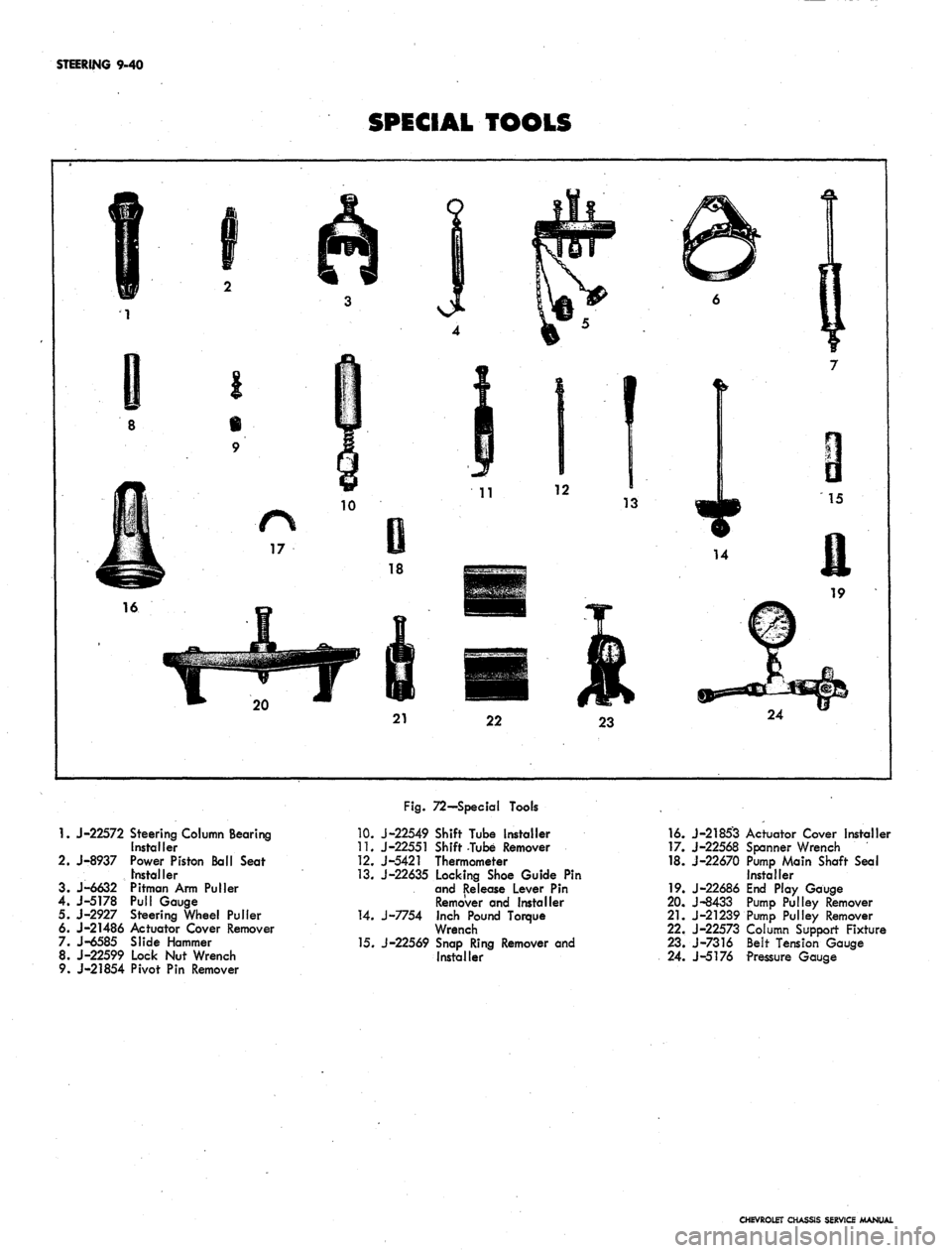
STEERING 9-40
SPECIAL TOOLS
1.
J-22572 Steering Column Bearing
Installer
2.
J-8937 Power Piston Ball Seat
Installer
3. J-6632 Pitman Arm Puller
4.
J-5178 Pull Gauge
5. J-2927 Steering Wheel Puller
6. J-21486 Actuator Cover Remover
7. J-6585 Slide Hammer
8. J-22599 Lock Nut Wrench
9. J-21854 Pivot Pin Remover
Fig.
72—Special Tools
10.
J-22549 Shift Tube Installer
11.
J-22551 Shift Tube Remover
12.
J-5421 Thermometer
13.
J-22635 Locking Shoe Guide Pin
and Release Lever Pin
Remover and Installer
14.
J-7754 Inch Pound Torque
Wrench
15.
J-22569 Snap Ring Remover and
Installer
16.
J-2185'3
17.
J-22568
18.
J-22670
19.
J-22686
20.
J-8433
21.
J-21239
22.
J-22573
23.
J-7316
24.
J-5176
Actuator Cover Installer
Spanner Wrench
Pump Main Shaft Seal
Installer
End Play Gauge
Pump Pulley Remover
Pump Pulley Remover
Column Support Fixture
Belt Tension Gauge
Pressure Gauge
CHEVROLET CHASSIS SERVICE MANUAL
Page 485 of 659

WHEELS AND TIRES 10-5
WHEELS
The wheel and tire assembly should be removed from
vehicles equipped with disc brakes to properly perform
balancing operations. This is necessary due to drag of
the spring loaded brake shoes on the disc.
Static Balancing (W/Tire)
Static Balance (still balance) is the equal distribution
of weight of the wheel and tire assembly about the axis
of rotation so that the assembly has no tendency to rotate
by
itself.
Static unbalance causes the pounding action of
the front wheels that is called "tramp".
To correct static unbalance (front and rear): The
quickest and best methods to correct static unbalance
are through the use of wheel balancers which are com-
mercially available. Refer to the Information and in-
structions included with these balaricers.
Dynamic Balancing (W/Tire)
Dynamic Balance (running balance) requires the wheel
to be not only in static balance, but balanced and running
smoothly while turning on an axis which runs through the
centerline of the wheel and tire perpendicular to the axis
of rotation.
The quickest and best methods of testing and correcting
dynamic unbalance are by the use of dynamic wheel
balancers which are commercially available. These bal-
ancers include all necessary information on where and
how the balancing weights should be placed. The follow-
ing information, however, will help in the correction of
dynamic balance.
NOTE:
Before attempting to balance the
wheels, check to be certain that no foreign
matter has been trapped in the wheel ventila-
tion slots or in the accessory wheel discs. This
is especially important if the vehicle has been
run in soft mud and then parked in freezing
weather.
When a wheel that is statically unbalanced is dynam-
ically in balance the dynamic balance can be retained
while correcting "the static balance by installing the cor-
rective weights so that half of the weight required is
placed on the inner edge of the rim and the other half
on the outer edge of the rim.
Dynamic unbalance can be corrected without destroying
static balance by installing weights so half of weight
required for dynamic balance is placed on the rim op-
posite the heavy point, while the other half is placed 180°
away and on the opposite side of the rim.
NOTE:
Vehicles with wire wheel covers should
have the wheels balanced with the wire wheel
covers installed on the wheels.
Run Out (W/OTire)
The wheels should not run out (wobble) more than
1/16" as measured on the side of the rim at the base
of the tire. Excessive run-out is the result of a bent
wheel, an improperly mounted wheel, worn knuckle bear-
ings or steering connections. These parts should be
checked for correct adjustment, proper alignment and
wear whenever excessive run-out is encountered.
The wheels should also run concentric with the steering
knuckle spindle within 1/16 inch as measured on the tire
bead seat of the rim with the tire removed.
Wheel run-out, eccentricity and balance are closely
associated with steering and front wheel alignment.
Further information on these subjects will be found under
"Suspension".
Cleaning Aluminum Wheels
Do not use wire brush or abrasive cleaners when
cleaning wheels. Use only cleaners that will not react
with aluminum.
SERVICE OPERATIONS
TIRES
Removal
Dismounting tubeless tires presents no problems if the
correct procedures are used and the following precau-
tions observed.
1.
Remove the valve cap and valve core. Let out all the
air.
2.
Press the inner side of the tire into the rim well.
Use bead loosening tool or if regular tire irons are
used, take particular care not to injure or tear the
sealing ribs on the bead.
CAUTION: Never use tire irons with sharp
edges or corners.
3.
Using tire irons on the opposite side, remove bead,
taking small "bites" around the rim.
4.
Turn the tire over, and use two tire irons, one be-
tween the rim flange and the bead to pry the rim
upward, the other iron to pry outward between the
bead seat and the bead.
Installation
Extreme care must be exercised to prevent injury to
the sealing bead and circumferential bead when forcing
tire over rim.
1.
Apply a light film of Ruglyde or other suitable rubber
lubricant to sealing bead of tire.
NOTE:
The use of excessive lubrication may
lead to rim slippage and subsequent breaking of
air seal.
2.
Carefully mount the outer bead in usual manner by
using tire irons, taking small "bites" around rim,
being careful not to injure the tire bead.
CAUTION: DO NOT use a hammer, as damage
to the bead will result.
3.
Install the inner bead in the same manner.
NOTE:
If a seal cannot be effected in the fore-
going manner with the rush of air it can be
, accomplished by applying to the circumference
of the tire a tire mounting band or heavy sash
cord and tightening with the use of a tire iron.
On tire mounting machines, bouncing the tire
assembly is not required. The tire should be
CHEVROLET CHASSIS SERVICE MANUAL
Page 502 of 659

CHASSIS SHEET METAL 11-15
FRONT FENDER TRIM
If fender spear molding is to be replaced without re-
moving fender from vehicle, proceed as follows:
1.
Perform Operations 2 and 5 only of Front Fender
Assembly—Removal.
2.
Pull rear* end of fender away from body far enough
to insert a short piece of 2 x 4 between lower rear
corner of fender and rocker panel extension.
3.
It should now be possible to gain access to first and
second retaining nuts forward of rear end of fender.
All other nuts can be reached from front wheel
opening.
SKIRT ASSEMBLY
Removal
1.
Remove hood and hinge assemblies as outlined in
this section.
2.
Remove grille and radiator support as outlined in
Section ia.
3.
Remove fender assembly as outlined in this section.
4.
Raise car from floor and place jack stands under
rocker panel extension.
5.
Remove suspension bumper support, shock absorber,
front spring and stabilizer link as outlined in Section
3.
6. If removing left skirt assembly, remove steering
gear mounting bolts, power steering hose clamp (if
so equipped) and outer (left) clutch cordon shaft
bracket (if so equipped).
7.
Remove tie rod ball stud from steering arm as out-
lined in Section 9.
8. Support engine and remove engine mount cushion as
outlined in Section 6.
9. Remove spring clip from brake line junction which
passes through skirt and remove junction from skirt
(see Section 5).
10.
Remove four bolts retaining front crossmember to
skirt.
11.
Remove four bolts retaining skirt assembly to dash
front brace. Remove 3 bolts retaining upper end of
skirt to dash (fig. 26); record shims removed.
12.
Remove skirt assembly with remaining suspension
parts attached as shown in Figure 27.
13.
Suspension parts may be detached as outlined in
Section 3.
Fig.
22 - Radiator Support Assembly
CHEVROLET CHASSIS SERVICE MANUAL
Page 504 of 659
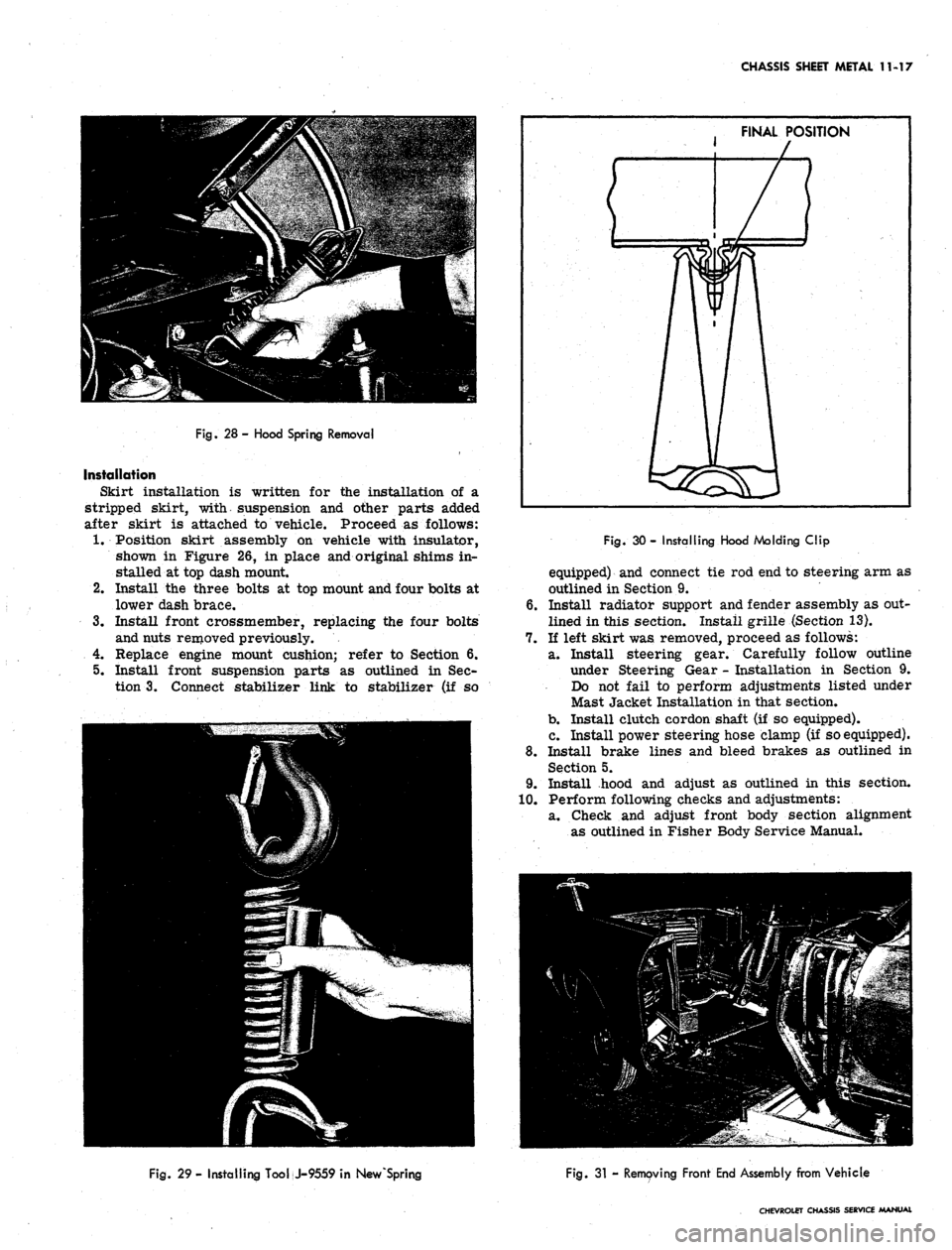
CHASSIS SHEET METAL 11-17
Fig.
28- Hood Spring Removal
Installation
Skirt installation is written for the installation of a
stripped skirt, with suspension and otiier parts added
after skirt is attached to vehicle. Proceed as follows:
1.
Position skirt assembly on vehicle with insulator,
shown in Figure 26, in place and original shims in-
stalled at top dash mount
2.
Install the three bolts at top mount and four bolts at
lower dash brace.
3.
Install front crossmember, replacing the four bolts
and nuts removed previously.
4.
Replace engine mount cushion; refer to Section 6.
5.
Install front suspension parts as outlined in Sec-
tion 3. Connect stabilizer link to stabilizer (if so
FINAL POSITION
Fig.
30 - Installing Hood Molding Clip
equipped) and connect tie rod end to steering arm as
outlined in Section 9.
6. Install radiator support and fender assembly as out-
lined in this section. Install grille (Section 13).
7.
If left skirt was removed, proceed as follows:
a. Install steering gear. Carefully follow outline
under Steering Gear - Installation in Section 9.
Do not fail to perform adjustments listed under
Mast Jacket Installation in that section.
b.
Install clutch cordon shaft (if so equipped).
c. Install power steering hose clamp (if so equipped).
8. Install brake lines and bleed brakes as outlined in
Section 5.
9. Install hood and adjust as outlined in this section.
10.
Perform following checks and adjustments:
a. Check and adjust front body section alignment
as outlined in Fisher Body Service Manual.
Fig.
29 - Installing Tool J-9559 in Nev/Spring
Fig.
31 - Removing Front End Assembly from Vehicle
CHEVROLET CHASSIS SERVICE MANUAL
Page 505 of 659
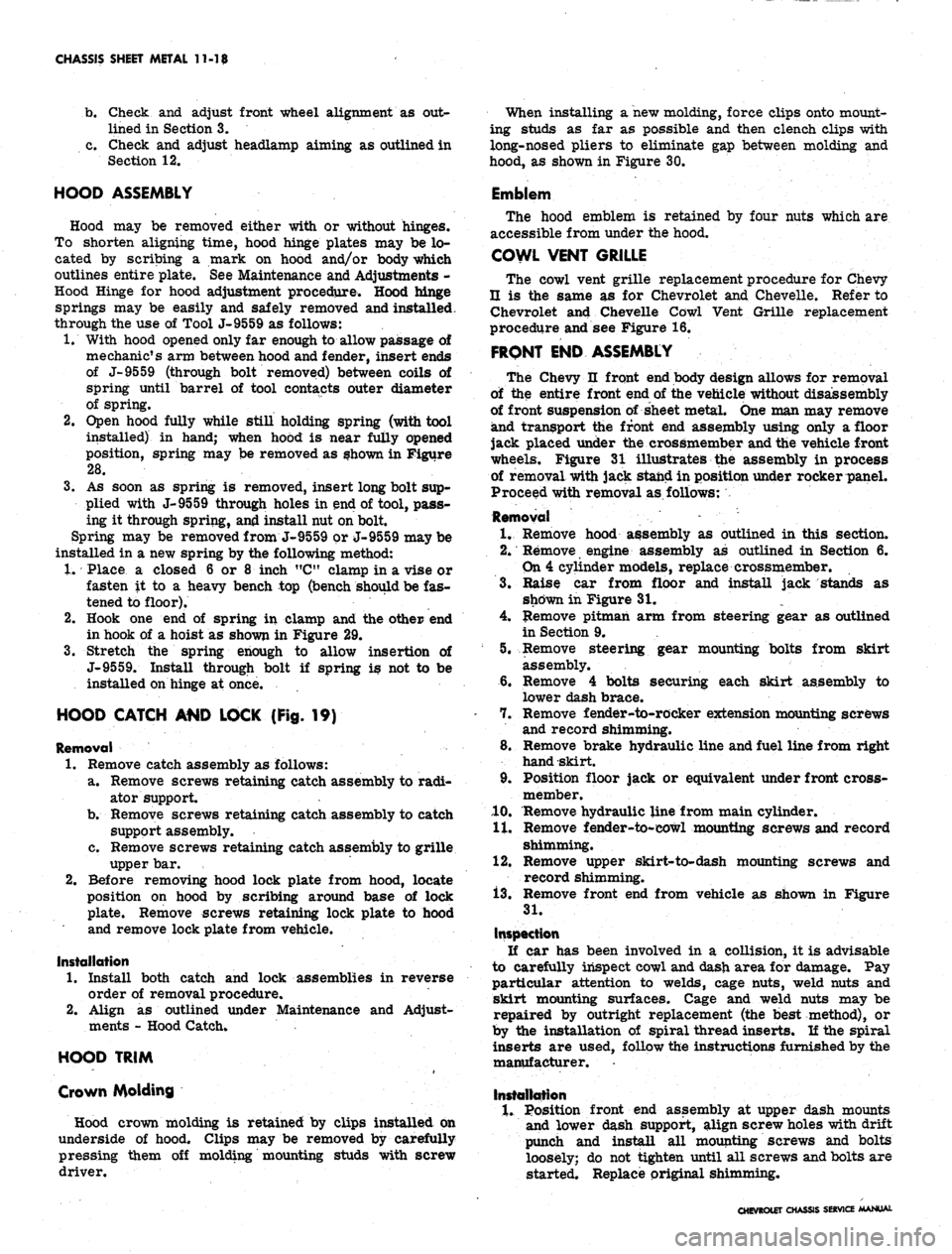
CHASSIS SHEET METAL 11-18
b.
Check and adjust front wheel alignment as out-
lined in Section 3.
c. Check and adjust headlamp aiming as outlined in
Section 12.
HOOD ASSEMBLY
Hood may be removed either with or without hinges.
To shorten aligning time, hood hinge plates may be lo-
cated by scribing a mark on hood and/or body which
outlines entire plate. See Maintenance and Adjustments -
Hood Hinge for hood adjustment procedure. Hood hinge
springs may be easily and safely removed and installed.
through the use of Tool J-9559 as follows:
1.
With hood opened only far enough to allow passage of
mechanic's arm between hood and fender, insert ends
of J-9559 (through bolt removed) between coils of
spring until barrel of tool contacts outer diameter
of spring.
2.
Open hood fully while still holding spring (with tool
installed) in hand; when hood is near fully opened
position, spring may be removed as shown in Figure
28.
3.
As soon as spring is removed, insert long bolt sup-
plied with J-9559 through holes in end of tool, pass-
ing it through spring, and install nut on bolt.
Spring may be removed from J-9559 or J-9559 may be
installed in a new spring by the following method:
1.
Place a closed 6 or 8 inch "C" clamp in a vise or
fasten it to a heavy bench top (bench should be fas-
tened to floor).
2.
Hook one end of spring in clamp and the other end
in hook of a hoist as shown in Figure 29.
3.
Stretch the spring enough to allow insertion of
J-9559. Install through bolt if spring is not to be
installed on hinge at once.
HOOD CATCH AMD LOCK (Fig. 19)
Removal
1.
Remove catch assembly as follows:
a. Remove screws retaining catch assembly to radi-
ator support.
b.
Remove screws retaining catch assembly to catch
support assembly.
c* Remove screws retaining catch assembly to grille
upper bar.
2.
Before removing hood lock plate from hood, locate
position on hood by scribing around base of lock
plate. Remove screws retaining lock plate to hood
and remove lock plate from vehicle.
Installation
1.
Install both catch and lock assemblies in reverse
order of removal procedure.
2.
Align as outlined under Maintenance and Adjust-
ments - Hood Catch.
HOOD TRIM
Crown Molding
Hood crown molding is retained by clips installed on
underside of hood. Clips may be removed by carefully
pressing them off molding mounting studs with screw
driver.
When installing a new molding, force clips onto mount-
ing studs as far as possible and then clench clips with
long-nosed pliers to eliminate gap between molding and
hood, as shown in Figure 30.
Emblem
The hood emblem is retained by four nuts which are
accessible from under the hood.
COWL VENT GRILLE
The cowl vent grille replacement procedure for Chevy
U is the same as for Chevrolet and Chevelle. Refer to
Chevrolet and Chevelle Cowl Vent Grille replacement
procedure and see Figure 16.
FRONT END ASSEMBLY
The Chevy n front end body design allows for removal
of the entire front end of the vehicle without disassembly
of front suspension of sheet metal. One man may remove
and transport the front end assembly using only a floor
jack placed under the crossmember and the vehicle front
wheels. Figure 31 illustrates the assembly in process
of removal with jack stand in position under rocker panel.
Proceed with removal
as.
follows:
Removal
1.
Remove hood assembly as outlined in this section.
2.
Remove engine assembly as outlined in Section 6.
On 4 cylinder models, replace crossmember.
3.
Raise car from floor and install jack stands as
shown in Figure 31.
4.
Remove pitman arm from steering gear as outlined
in Section 9.
5.
Remove steering gear mounting bolts from skirt
assembly.
6. Remove 4 bolts securing each skirt assembly to
lower dash brace.
7.
Remove fender-to-rocker extension mounting screws
and record shimming.
8. Remove brake hydraulic line and fuel line from right
hand skirt.
9. Position floor jack or equivalent under front cross-
member.
10.
Remove hydraulic line from main cylinder.
11.
Remove fender-to-cowl mounting screws and record
shimming.
12.
Remove upper skirt-to-dash mounting screws and
record shimming.
13.
Remove front end from vehicle as shown in Figure
31.
Inspection
If car has been involved in a collision, it is advisable
to carefully inspect cowl and dash area for damage. Pay
particular attention to welds, cage nuts, weld nuts and
skirt mounting surfaces. Cage and weld nuts may be
repaired by outright replacement (the best method), or
by the installation of spiral thread inserts. If the spiral
inserts are used, follow the instructions furnished by the
manufacturer. -
Installation
%, position front end assembly at upper dash mounts
and lower dash support, align screw holes with drift
punch and install all mounting screws and bolts
loosely; do not tighten until all screws and bolts are
started. Replace original shimming.
CHEVROLET CHASSIS SERVICE MANUAL
Page 506 of 659
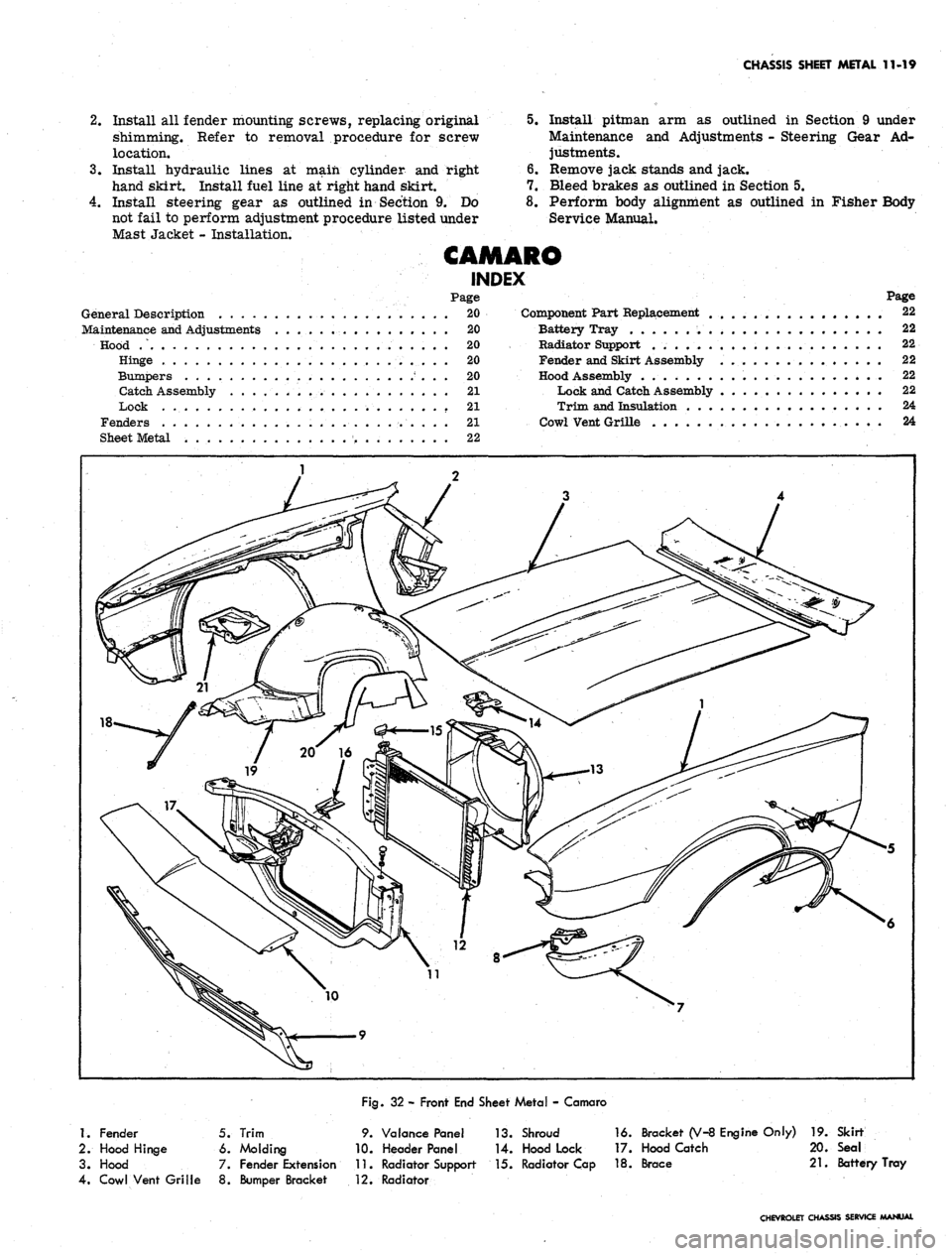
5.
6.
7.
8.
2.
Install all fender mounting screws, replacing original
shimming. Refer to removal procedure for screw
location.
3.
Install hydraulic lines at main cylinder and right
hand skirt. Install fuel line at right hand skirt.
4.
Install steering gear as outlined in Section 9. Do
not fail to perform adjustment procedure listed under
Mast Jacket - Installation.
CAMARO
INDEX
Page
General Description 20
Maintenance and Adjustments 20
Hood / . 20
Hinge 20
Bumpers ' . . . 20
Catch Assembly 21
Lock . 21
Fenders 21
Sheet Metal 22
CHASSIS SHEET METAL 11-19
Install pitman arm as outlined in Section 9 under
Maintenance and Adjustments - Steering Gear Ad-
justments.
Remove jack stands and jack.
Bleed brakes as outlined in Section 5.
Perform body alignment as outlined in Fisher Body
Service Manual.
Page
Component Part Replacement . 22
Battery Tray 22
Radiator Support 22
Fender and Skirt Assembly 22
Hood Assembly . 22
Lock and Catch Assembly 22
Trim and Insulation . . . 24
Cowl Vent Grille . . 24
Fig.
32 - Front End Sheet Metal - Camaro
1.
Fender
2.
Hood Hinge
3. Hood
4.
Cowl Vent Grille
5. Trim
6. Molding
7. Fender Extension
8. Bumper Bracket
9. Valance Pane!
10.
Header Panel
11.
Radiator Support
12.
Radiator
13.
14.
15.
Shroud
Hood Lock
Radiator Cap
16.
17.
18.
Bracket (V-8
Hood Catch
Brace
Engine
Only)
19.
20.
21.
Skirt
Seal
Battery
Tray
CHEVROLET CHASSIS SERVICE MANUAL